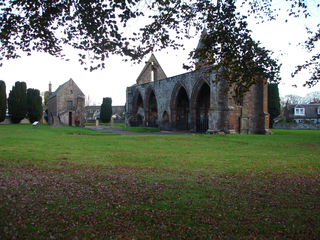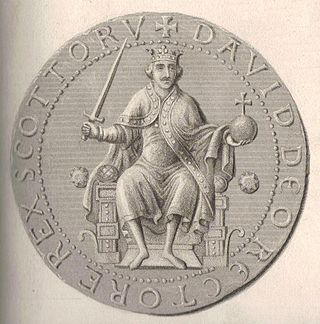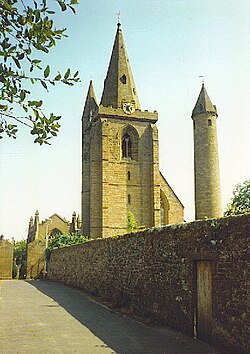The Scottish Episcopal Church is the ecclesiastical province of the Anglican Communion in Scotland.
The Bishop of Aberdeen was the ecclesiastical head of the Diocese of Aberdeen, one of Scotland's 13 medieval bishoprics, whose first recorded bishop is an early 12th-century cleric named Nechtan. It appears that the episcopal seat had previously been at Mortlach (Mòrthlach), but was moved to Aberdeen during the reign of King David I of Scotland. The names of three bishops of Mortlach are known, the latter two of whom, "Donercius" and "Cormauch" (Cormac), by name only. The Bishop of Aberdeen broke communion with the Roman Catholic Church after the Scottish Reformation. Following the Revolution of 1688, the office was abolished in the Church of Scotland, but continued in the Scottish Episcopal Church. A Roman Catholic diocese was recreated in Aberdeen in 1878.
The Bishop of Dunkeld is the ecclesiastical head of the Diocese of Dunkeld, one of the largest and more important of Scotland's 13 medieval bishoprics, whose first recorded bishop is an early 12th-century cleric named Cormac. However, the first known abbot dates to the 10th century, and it is often assumed that in Scotland in the period before the 12th century, the roles of both bishop and abbot were one and the same. The Bishopric of Dunkeld ceased to exist as a Catholic institution after the Scottish Reformation but continued as a royal institution into the 17th century. The diocese was restored by Pope Leo XIII on 4 March 1878; it is now based in the city of Dundee.

The Archbishop of Glasgow is an archiepiscopal title that takes its name after the city of Glasgow in Scotland. The position and title were abolished by the Church of Scotland in 1689; and, in the Scottish Episcopal Church, it is now part of the Episcopal bishopric of Glasgow and Galloway. In the Roman Catholic Church, the title was restored by Pope Leo XIII in 1878.
The Bishop of Argyll and The Isles is the Ordinary of the Scottish Episcopal Diocese of Argyll and the Isles.

The Diocese of Brechin is in the east of Scotland, and is the smallest of the seven dioceses of the Scottish Episcopal Church. It covers the historic counties of Angus and Kincardineshire. It stretches from Muchalls in the north east down to Dundee in the south, and across to Glencarse in the south west. The cathedral and administrative centre is St Paul’s Cathedral in Dundee. The diocese continues to be named after its medieval centre of Brechin.
The Bishop of Edinburgh, or sometimes the Lord Bishop of Edinburgh, is the ordinary of the Scottish Episcopal Diocese of Edinburgh.

The Diocese of Dunkeld was one of the 13 historical dioceses of Scotland preceding the abolition of Episcopacy in 1689.

The Bishop of Ross was the ecclesiastical head of the Diocese of Ross, one of Scotland's 13 medieval bishoprics. The first recorded bishop appears in the late 7th century as a witness to Adomnán of Iona's Cáin Adomnáin. The bishopric was based at the settlement of Rosemarkie until the mid-13th century, afterwards being moved to nearby Fortrose and Fortrose Cathedral. As far as the evidence goes, this bishopric was the oldest of all bishoprics north of the Forth, and was perhaps the only Pictish bishopric until the 9th century. Indeed, the Cáin Adomnáin indicates that in the reign of Bruide mac Der Ilei, king of the Picts, the bishop of Rosemarkie was the only significant figure in Pictland other than the king. The bishopric is located conveniently close to the heartland of Fortriu, being just across the water from Moray.

The Bishop of Caithness was the ecclesiastical head of the Diocese of Caithness, one of Scotland's 13 medieval bishoprics. The first referenced bishop of Caithness was Aindréas, a Gael who appears in sources between 1146 and 1151 as bishop. Aindréas spent much if not all of his career outside his see.
The Bishop of Moray or Bishop of Elgin was the ecclesiastical head of the Diocese of Moray in northern Scotland, one of Scotland's 13 medieval bishoprics. If the foundation charter of the monastery at Scone is reliable, then the Bishopric of Moray was in existence as early as the reign of King Alexander I of Scotland (1107–1124), but was certainly in existence by 1127, when one Gregoir ("Gregorius") is mentioned as "Bishop of Moray" in a charter of king David I of Scotland. The bishopric had its seat at Elgin and Elgin Cathedral, but was severally at Birnie, Kinneddar and as late as Bishop Andreas de Moravia at Spynie, where the bishops continued to maintain a palace. The Bishopric's links with Rome ceased to exist after the Scottish Reformation, but continued, saving temporary abolition between 1638 and 1661, under the episcopal Church of Scotland until the Revolution of 1688. Episcopacy in the established church in Scotland was permanently abolished in 1689. The Bishops fortified seat for over 500 years was at Spynie Palace.

The Bishop of Dunblane or Bishop of Strathearn was the ecclesiastical head of the Diocese of Dunblane or Strathearn, one of medieval Scotland's thirteen bishoprics. It was based at Dunblane Cathedral, now a parish church of the Church of Scotland. The bishopric itself certainly derives from an older Gaelic Christian community. According to legend, the Christian community of Dunblane was derived from the mission of St. Bláán, a saint originally associated with the monastery of Cenn Garath (Kingarth) on the Isle of Bute. Although the bishopric had its origins in the 1150s or before, the cathedral was not built nor was the seat (cathedra) of the diocese fixed at Dunblane until the episcopate of Clement.
Andreas or Aindréas of Caithness is the first known bishop of Caithness and a source for the author of de Situ Albanie. Aindréas was a native Scot, and very likely came from a prominent family in Gowrie, or somewhere in this part of Scotland. He was a prominent landowner in Gowrie, Angus and Fife, and it is likely that he was a brother of one Eòghan "of Monorgan", another Gowrie landlord. At some stage in his career, he was a monk of Dunfermline Abbey, though it is not known if this was before or during his period as bishop of Caithness.
The Bishop of St Andrews, Dunkeld and Dunblane is the Ordinary of the Scottish Episcopal Diocese of St Andrews, Dunkeld and Dunblane. The see is located at St Ninian's Cathedral in Perth, Scotland.

St Ninian's Cathedral in Perth is a cathedral of the Scottish Episcopal Church in the Diocese of St Andrews, Dunkeld and Dunblane.

Historical treatment of David I and the Scottish church usually emphasises King David I of Scotland's pioneering role as the instrument of diocesan reorganisation and Norman penetration, beginning with the bishopric of Glasgow while David was Prince of the Cumbrians, and continuing further north after David acceded to the throne of Scotland. As well as this and his monastic patronage, focus too is usually given to his role as the defender of the Scottish church's independence from claims of overlordship by the Archbishop of York and the Archbishop of Canterbury.

Lawrence Edward Luscombe OStJ was a British Anglican bishop and author. He was Bishop of Brechin from 1975 to 1990 and primus of the Scottish Episcopal Church from 1985 to 1990.
Nigel Peyton is a retired British Anglican bishop. From 2011 until 2017, he served as the Bishop of Brechin in the Scottish Episcopal Church.
Andrew Christopher Swift, is a British Anglican bishop and former engineer. Since 2018, he has been the Bishop of Brechin in the Scottish Episcopal Church.










